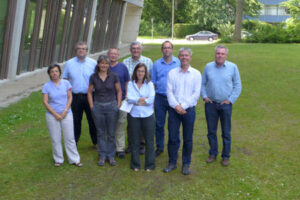Tasks for DPAC
-
General view
-
CU1: System Architecture
-
CU2: Data Simulations
-
CU3: Core Processing
-
CU5: Photometric Processing
-
CU9: Catalogue Access
-
DPCB: Data Processing Center of Barcelona
-
Working groups: PE, RTF, IIOC,OITF
-
DPACE
-
GST
General view
In 2007 ESA issued an Announcement of Opportunity to select one scientific consortium in charge of the design, management and reduction of the data produced by Gaia. The European Scientific comunity, organized in the DACC (Data Analysis Coordination Committee) that included members of our team, responded with a proposal (see reference below) by the Gaia Data Processing & Analysis Consortium (DPAC) selected by ESA. The DPAC is basically organized around eight Coordination Units (CUs) and supervised by the DPAC Executive Committee (DPACE). More info at General View of DPAC
CU1: System Architecture
Our group has developed the TmTools routines, which has served as the interface between the Simulators (GASS and GIBIS simulators of CU2) and the data processing systems (starting with CU1 Mission Operations Centre Interface Task, MIT, and CU3 Initial Data Treatment, IDT). During operations, the TmTools routines is used for the decoding of the raw telemetry from the satellite.
Additionally, our group participates in the Configuration Control Board (CCB) for the definition of data model of the Main Database (for the CU2 and CU3 sections).
CU2: Data Simulations
CU2 is in charge of developing the Gaia simulator that gives simulated data to allow the development and validation of the data reduction of the mission, also generating big simulated samples to the common usage of the other CUs. Barcelona team has a strong participation in this Coordination Unit. We are responsible of several of the most important modules, as two of the data generators: GASS, designed to generate big dataset of Gaia telemetry in order to prepare the data reduce algorithm; and GOG, able to generate the final mission catalogue. Among other, we have simulated several days of complete telemetry and a full sky snapshot. More info at CU2: Data Simulations
CU3: Core Processing
The task of CU3 is to organise and implement the data processing chain all the way from receiving Gaia’s raw telemetry down to the core astrometric solution. Thanks to a known experience and deep knowledge of the mission, our group is in charge, from the beginning of DPAC, of the design and most of the implementation of IDT and IDU. More information at CU3:: Core Processing.
CU5: Photometric Processing
We participate in the Photometry Coordination Unit (CU5), in charge of defining and developing the process of treatment, calibration and publishing of photometric and spectrophotometric data. Our group leads DU12 (responsible of the definition of internal calibration models) and DU16 (selection of internal reference sources for the flux and wavelength calibration) and collaborates on the DU13 (ground-based observations for absolute fluxes). More information at CU5: Photometric Processing
CU9: Catalogue Access
ESA issued an Announcement of Opportunity for the design, implementation and operation of the Gaia archive, delegated by ESA to the scientific community through a new CU9. A consortium led by X. Luri was formally appointed by ESA for this task in Feb 2013. More relevant if we consider that Gaia has no instrument PIs. This great success has also allowed us to lead an FP7 project GENIUS devoted to CU9 tasks.
We are involved in several working packages inside CU9, as validation tasks, educational and outreach activities or science enabling applications. More information at CU9: Catalogue Access
DPCB: Data Processing Center of Barcelona
The Data Processing Center of Barcelona (DPCB) must provide the necessary resources for testing some critical data reduction algorithms in a realistic environment (prior delivery to ESAC), for executing the GASS simulator (including large-scale simulations), and especially it must provide the platform and resources for executing IDU during operations – reprocessing real data from the spacecraft. Thus, DPCB plays a key role in DPAC. It is composed of CSUC (for IDT testing), BSC (for GASS and IDU executions), and our team. The important software developments associated to these operations, mainly regarding execution frameworks, are in charge of our group with support from the BSC engineering team, and CSUC team also provides support on database operation and configuration. More information at DPCB: Data Processing Center of Barcelona
Working groups: PE, RTF, IIOC,OITF
Several members of our team belongs to some inter-coordination unit working groups, created to study specific problems of the mission: the Payload Experts (PE) monitor the health of the satellite based on all daily processing systems and provide advice to the Project Scientist and Mission Manager on identified improvements,
the Radiation Task Force (RTF) to study the way the effects of radiation damage may be corrected in the Gaia data processing, and to coordinate measures to do so between the different CUs; the Calibration Task Force (CTF) group which is in charge of the definition for the calibration activities; and the Offset Instability Task Force (OITF) to deal with issues surrounding the PEM-CCD offset instability.
DPACE
The Gaia Data Processing and Analysis Consortium Executive (DPACE) was established in June 2006 and It oversees DPAC activities. Xavi Luri is in DPACE as Manager of CU9 (Catalogue Access)
GST
The role of the Gaia Science Team (GST) is to advise ESA, through the Project Scientist, on all top-level science performance, science policy and science organisation aspects of the mission. Carme Jordi is member of GST.







